This Beef Ragu recipe is cozy, elevated comfort food to rival any restaurant, easy to make, and tastes even better the next day for make-ahead magic!
This Beef Ragu Sauce is a must-have/must-make recipe for every home cook! It’s rich, hearty, saucy and satisfying, exploding with bright tomato, basil, garlic flavors and spoon tender shredded beef. This Beef Ragu recipe may look fancy, but is super easy to make, most of the time is hand’s off simmering! Chuck roast is cooked low and slow in a bath of San Marzano tomatoes, garlic, onions, carrots, celery, and fresh basil until melt-in-your-mouth tender, then shredded and piled on buttery, chewy pappardelle with a showering of Parmesan cheese. This ragu sauce is also make-ahead and freezer friendly so you can always have it on hand. Serve it with Caesar Salad and Garlic Bread or Breadsticks for a comforting dinner everyone will love.
Pasta dinners are favorites of adults and kids alike – especially with beef! Some of our favorites beef pasta recipes include: Bolognese, Lasagna, Lasagna Soup, Manicotti, and Baked Penne.
How to Make Beef ragu recipe Video


WHY YOU’LL LOVE this Ragu Recipe
Tender beef: The beef is cooked low and slow until it’s buttery, melt-in-your mouth tender and dripping with flavor – just watch the video!
Incredible sauce: Vegetables, aromatics, herbs, San Marzano tomatoes and my secret ingredient combine with the slow cooked beef for an unparalleled, rich depth of flavor.
Shortcut sauce: I chop my onions, carrot and celery in a food processor which means almost ZERO chopping.
Ideal to make ahead: Letting the ragu rest overnight in the ridge makes it that much more irresistible as the flavors blend and harmonize – now just warm up the sauce for an easy, make ahead dinner.
Perfect for company: EVERYONE loves Beef Ragu; plus, all you have to do is reheat it from the night before for stress free entertaining.
Makes a large quantity: This ragu recipe can be enjoyed for multiple dinners, frozen, taken to new moms or someone who has had surgery, or it’s enough for large crowds, dinner parties or company.
Less Expensive: This ragu recipe tastes like you’re dining at a pricey Italian restaurant but you can serve the entire family for the same price as one serving!
Freezer friendly. Enjoy some now and freeze some for later!
Beef Ragu FAQS
Ragu is a meat-based Italian sauce made with any type of protein (veal, beef, lamb, pork, fish or poultry), onions, carrots, celery and often pancetta with a minimal amount of tomato sauce. The recipe I’m sharing with you today is a Beef Ragu recipe made with chuck roast that’s been braised until fall-apart tender.
Ragu is an umbrella term for a meat-based Italian tomato sauce made with any type of protein (veal, beef, lamb, pork, fish or poultry), onions, carrots, celery and often pancetta. Bolognese is a popular type of ragu sauce characterized by its use of beef. So, all Bolognese recipes are a type of ragu, but not all ragu recipes are Bolognese. If you’re looking for a sensational Bolognese sauce, see this recipe.
Boneless chuck roast (which can also be labeled as a shoulder roast, chuck eye roast, or arm chuck roast) is the best cut of beef for fall apart tender ragu. It boasts a succulent, beefy flavor and melt-in-your mouth texture due to its rich marbling. The marbling melts as it slow cooks, creating a self-basting effect that drips over the meat, keeping it extra juicy and infusing it with a coveted depth of flavor. It is guaranteed to become fall apart tender when cooked long enough.
Chuck roast is the best choice for shredding, although many other tough cuts such as brisket, rump roast, round roast and even flank and skirt steak can be used as long as they are cooked long enough, but they won’t be as flavorful. Take care that whatever beef cut you choose has rich marbling (fat=flavor and tenderness) because these cuts are already leaner than chuck roast.

Beef Ragu Ingredients
Homemade Beef Ragu tastes gourmet, but it comes together easily with ingredients I almost always have on hand. Exact measurements can be found in the recipe card at the end of this post, but here’s an overview of what’s needed to make ragu sauce from scratch:
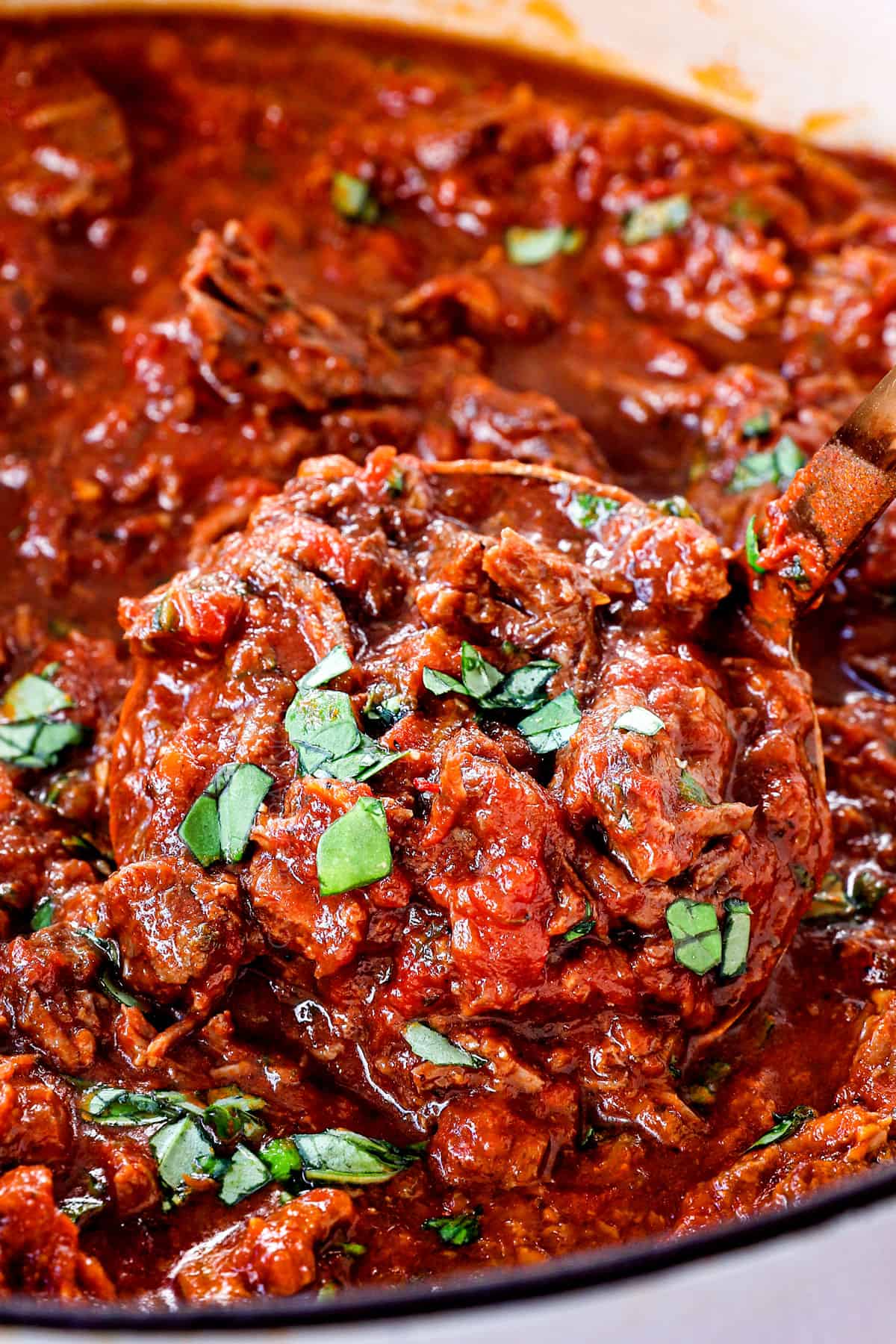
HOW TO MAKE Beef Ragu
I’ve provided two methods for cooking the ragu in the recipe card below. You can either simmer the sauce on the stove, or bake it in the oven. Both methods produce stellar Beef Ragu that’s studded with tender shredded beef; however, I prefer the oven method for more even cooking. Let’s review how to make it (full recipe in the printable recipe card at the bottom of the post):
- Step 1: Prepare the sofrito. Roughly chop the onion, celery, and carrots just so they fit in your food processor. Pulse until finely chopped (about 12 pulses), or chop by hand if desired.
- Step 2: Sear the beef. Pat the beef dry using paper towels, drizzle with oil, then evenly sprinkle with salt and pepper. Heat the vegetable oil in a large Dutch oven over high heat. Once hot, add the beef and sear on all sides until deeply browned. It will not be cooked through at this point, but that’s what you want!
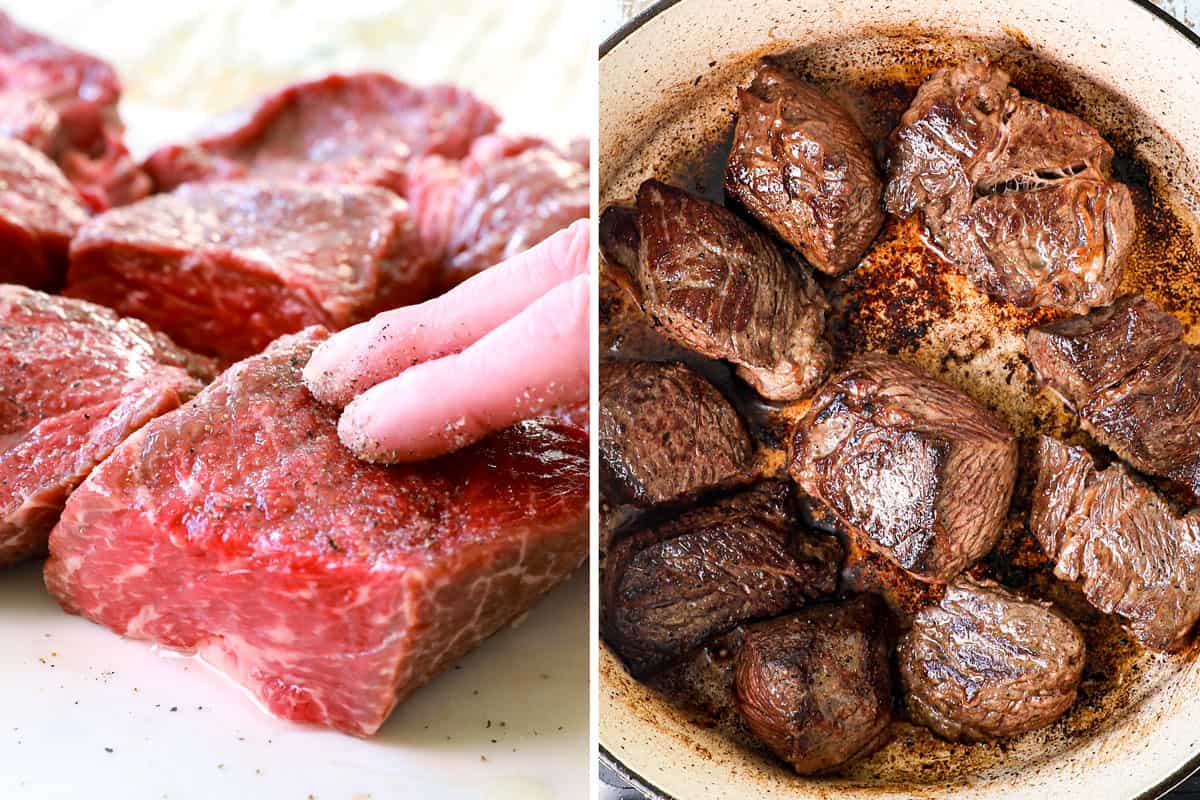
- Step 3: Sauté the aromatics. Remove the beef from the pan, then sauté the chopped sofrito in the drippings until softened. Briefly sauté the tomato paste to remove the tin-like taste, then add the garlic and red pepper flakes and cook for 30 more seconds.
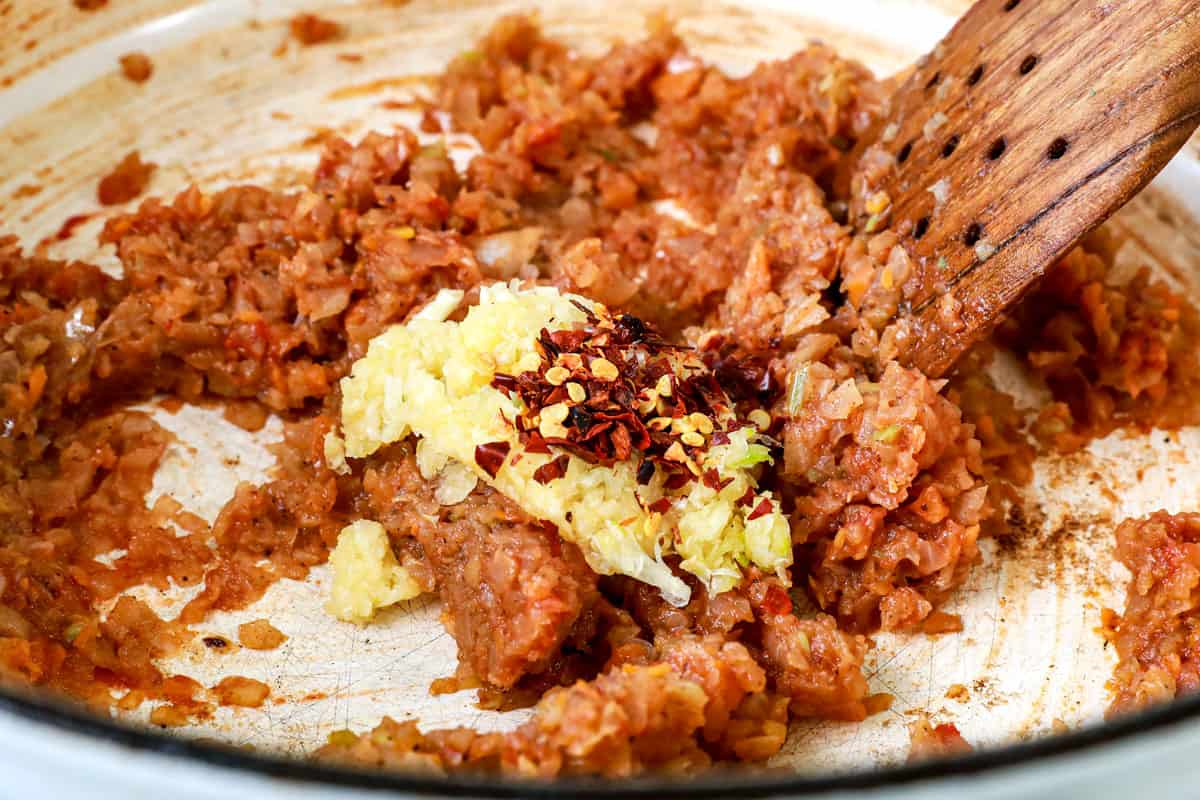
- Step 4: Add the remaining ingredients. Return the beef back to the pot along with crushed tomatoes, tomato sauce, beef bouillon and spices. Bring to a simmer, then continue to cook on the stove or in the oven.

- Step 5: Cook the sauce. Simmer the ragu sauce on the stove or bake it in the oven for about 2 ½ hours. Skim the fat off the surface of the sauce.
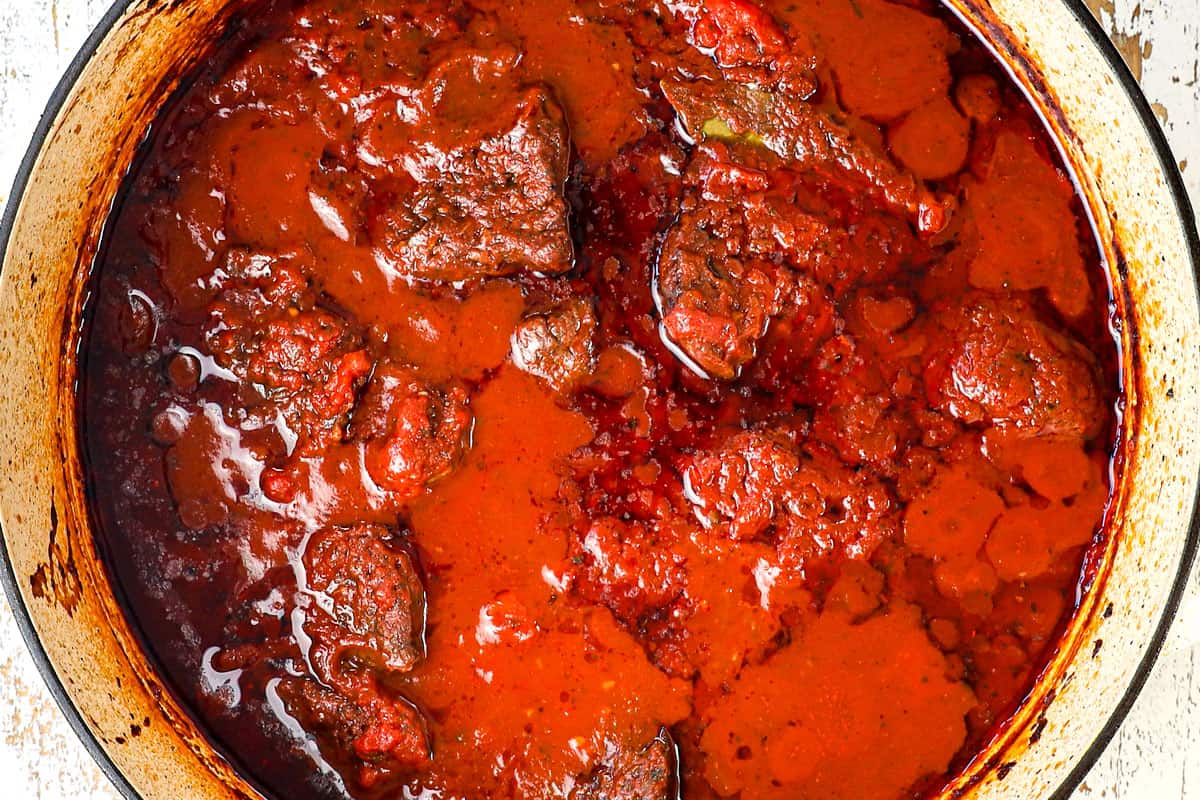
- Step 6: Shred the beef. Remove beef to a cutting board and shred with 2 forks. Return the beef to the pot.

- Step 7: Finish the sauce. Stir in fresh basil. Adjust seasonings as desired. Serve the Beef Ragu with pasta and plenty of freshly grated Parmesan cheese.


What Type of Pasta Is Served with Ragu?
Pappardelle is the traditional choice when it comes to serving Beef Ragu. It’s a long, thick pasta that holds up well when topped with the thick sauce. However, almost any sturdy pasta shape will work with ragu sauce. Think: fettuccine, tagliatelle, rigatoni, or even penne. I do not recommend using delicate or small pasta shapes such as linguine or macaroni; they’ll fall apart in the sauce.



Can this recipe be made in advance?
Ragu tastes 10X better the next day!!! The flavors develop, deepen and harmonize and the acidity tones down, so this Beef Ragu recipe is the ideal make ahead or meal prep dinner!
To meal prep, make the recipe as instructed, let it cool on the counter, then cover and store in the refrigerator until ready to serve. Reheat it in the same pot on the stove the next day!

How long is RAgu good for?
You will want to store your Beef Ragu separately from the pasta. The sauce will last up to 5 days in the fridge and pasta will last about 3 days.
-Ragu: Transfer to an airtight container and store in the refrigerator. Take care that the container is glass or ceramic as the sauce can stain plastic containers.
-Pasta: Toss it with a little olive oil to prevent it from sticking together. Store in a freezer-size plastic bag or airtight container in the refrigerator.

How do I reheat ragu sauce?
-Stovetop: Heat over medium until warmed through, stirring occasionally. The sauce will have thickened, so add a splash of broth, water, or even heavy cream, if desired, to thin.
-Microwave: Transfer sauce to a microwave-safe dish and microwave on high for 90 seconds, stir, then cook at 15-second intervals as needed.
-Oven: Bake in an oven safe pot for 15-20 minutes, or until warmed, at 350 degrees F, stirring halfway through.
can I freeze ragu sauce?
Homemade Beef Ragu freezes very well. To freeze:
1. Prepare the ragu recipe according to instructions.
2. Let the sauce cool completely.
3. Transfer the sauce to freezer-safe, airtight container(s). If using freezer, bags, squeeze out excess air. Label and seal.
4. Freeze for up to 3 months.
5. When ready to use, let the sauce thaw in the refrigerator overnight.


Looking for more pasta sauce Recipes?
Bolognese Sauce
Marinara Sauce
Healthier Alfredo Sauce
Pesto
Arrabbiata Sauce
Tomato Sauce
Brown Butter Herb Sauce
Sun-Dried Tomato Cream Sauce
WANT TO TRY THIS Ragu RECIPE?
PIN IT to your pasta recipe BOARD TO SAVE FOR LATER!
FIND ME ON PINTEREST FOR MORE GREAT RECIPES! I AM ALWAYS PINNING :)!
©Carlsbad Cravings by CarlsbadCravings.com
Tools Used in This Recipe
See Favorite Tools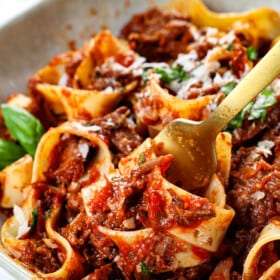
Beef Ragu
Save This Recipe To Your Recipe Box
You can now create an account on our site and save your favorite recipes all in one place!
Ingredients
Beef Ragu Sauce
- 1 medium yellow onion
- 2 carrots
- 2 stalks celery
- 2.5-3 lbs. chuck beef roast, cut into 8-10 equal pieces
- salt and pepper
- 2 tablespoons vegetable oil, plus more for drizzling
- 2 tablespoons olive oil
- 6-8 garlic cloves, minced
- 1/2-1 teaspoon red pepper flakes
- 1 28 oz. can crushed tomatoes (recommended San Marzano or fire roasted)
- 1 15 oz. can tomato sauce
- 2 tablespoons tomato paste
- 1/2 cup water
- 1 tablespoon dried parsley
- 1 tablespoon dried basil OR add ¼ cup fresh after simmering
- 1 tablespoon beef bouillon (base, granulated or cubes)
- 1 1/2 teaspoons dried oregano
- 1 teaspoon sugar, or more to taste
- 1/2 tsp EACH dried thyme
- 1 bay leaf
ADD LATER
- 1/4 cup chopped fresh basil (if not using dried)
FOR SERVING
- 1 lb pappardelle, or other thick pasta such as fettuccine or tagliatelle
- Freshly grated Parmesan cheese
Instructions
- Cooks's Note: Ragu tastes 10X better the next day!!! The flavors develop, deepen and harmonize and the acidity tones down. So, if possible, plan on making and refrigerating the recipe a day ahead of time.
- Prep: Preheat oven to 300 degrees F. Roughly chop onion, celery, and carrots just so they fit in your food processor. Pulse until finely chopped (about 12 pulses), or chop by hand; set aside.
- Sear beef: Pat beef dry and lighlty drizzle with vegetable oil. Evenly sprinkle with 1 teaspoon salt and ½ teaspoon pepper. Heat 2 tablespoons vegetable oil in a large Dutch oven over high heat. Once hot, add the cubed beef and sear until deeply browned; remove to a plate with tongs, don't wipe out pot.
- Sauté aromatics: Reduce heat to medium and add the 2 tablespoons olive oil. Add the chopped onion/celery/carrots and sauté for 5 minutes or until softened. Add the tomato paste and saute for one minute. Add the garlic and red pepper flakes and cook 30 more seconds.
- Add ingredients: Return the beef back to the pot (including any juices). Add all remaining sauce ingredients EXCEPT fresh basil.
- Bake: Bring to a simmer, cover, and transfer the pot to the preheated oven. Bake at 300 degrees F for 2 ½ hours or until beef easily shreds with two forks.
- Shred: Remove beef to a cutting board, then shred with 2 forks.
- Combine: Before returning beef to the pot, skim off excess fat from the sauce's surface with a spoon. Return shredded beef to the pot. Stir in fresh basil. Taste and season with additional salt, pepper, sugar or red pepper flakes to taste.
- Serve: Serve with pasta and plenty of freshly grated Parmesan cheese.
Video
Notes
- Beef bouillon: This adds a depth of concentrated beefy flavor which makes the ragu sauce taste like it’s been simmering all day – it is magic! You can use beef base (as seen in the video) such as Zoup! or Better Than Bouillon, granulated beef bouillon, or cubes, all in equal amounts. Add the bouillon directly to the pot, don’t dissolve in water first. If using cubes, make sure to crush them first.
- To simmer instead of bake: Reduce to a very gentle simmer, cover, and cook for 2-2 ½ hours or until beef easily shreds with two forks. There are more variables with the stovetop method, so I recommend the oven.
- Recipe variations: See post for variations, tips and tricks!
- Storage: Store the Beef Ragu separately from the pasta. The sauce will last up to 5 days in the fridge and pasta will last about 3 days. Take care that the container is glass or ceramic as the sauce can stain plastic containers. For the pasta, toss it with a little olive oil to prevent it from sticking together.
- To freeze: Let the sauce cool completely, then transfer to freezer-safe, airtight container(s). If using freezer, bags, squeeze out excess air. Freeze for up to 3 months. When ready to use, let the ragu thaw in the refrigerator overnight.
- To reheat: Heat on the stovetop over medium until warmed through; bake at 350 degrees F for 15-20 minutes, or until warmed, or microwave for 90 seconds, stir, then cook at 15-second intervals as needed until warmed through.

Did You Make This Recipe?
Tag @CarlsbadCravings and Use #CarlsbadCravngs
Leave a Review, I Always Love Hearing From You!



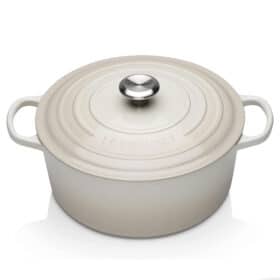
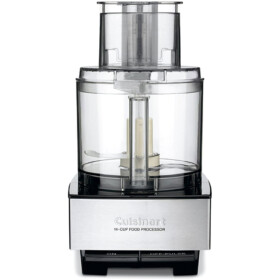


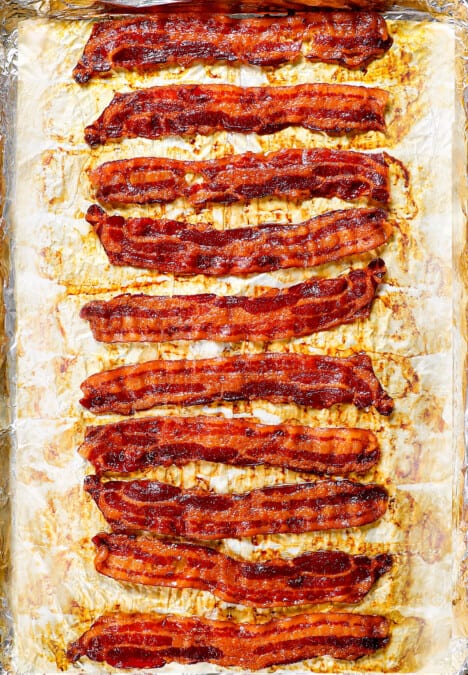
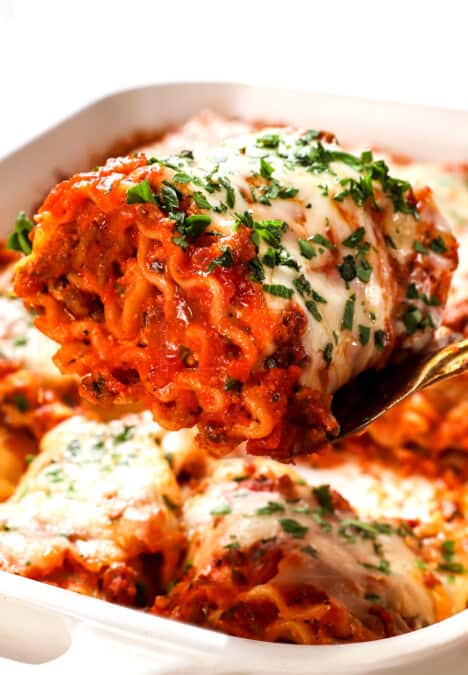
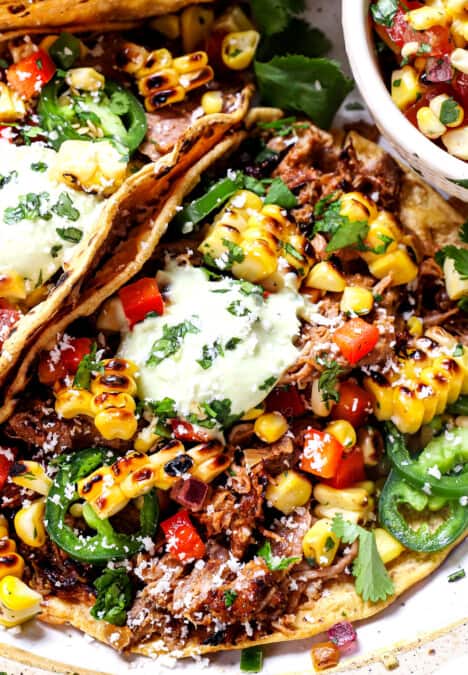
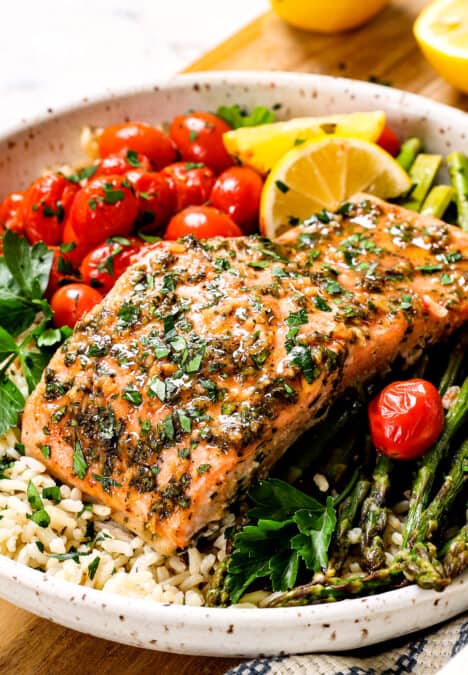
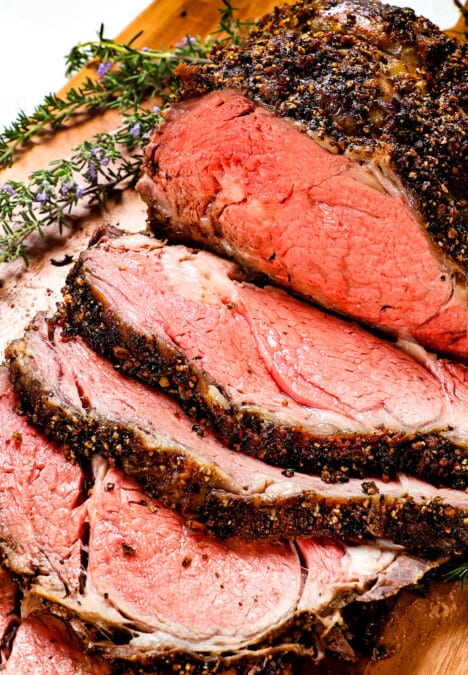
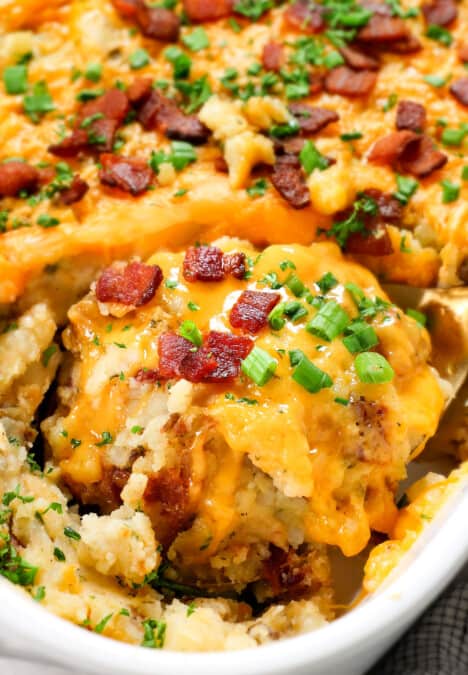























Melyssa Braman says
How much parsley?
Jen says
1 tablespoon, enjoy!
Toné says
This sauce was incredible! I didn’t go back for more pasta but I had to keep going back for more sauce. It’s delicious on its own.
Jen says
Thanks Toné, I’m so pleased you loved it so much!
Merry says
Could you make this with short ribs?
Jen says
Yes!
Ashley says
I bought beef bone-in short ribs, should I still sear them?
Jen says
Yes! Enjoy!
Lynzi says
HOLY CANNOLI. I have been making your recipes almost exclusively for about four years. This. Is. Amazing. You are so right about it tasting even better the next day. I ate so much of this & leftovers for two days and even then, wanted more. Thanks for this great recipe!
Jen says
I am so honored you have been making so many of my recipes Lynzi – thank you! I’m so pleased this recipe was a huge winner – you have great taste 😉
Kathy says
This sounds amazing…like other recipes of yours I have tried. Can you put this in a slow cooker instead of the oven?
Jen says
Yes! I haven’t personally tried it, but I am guessing the cook time would be about 5-7 hours on low.
Salesha says
This recipe is wonderful! I made it last week and it was surprisingly easy and sooo delicious! My baby enjoyed it as well. The recipe made a lot so I ended up freezing some. I look forward to having it again.
Jen says
Thanks Salesha, I’m so pleased you found it easy and delicious! I love frozen leftovers of this recipe!
Michelle says
Is the a nutrition guide please
Jen says
https://www.myfitnesspal.com/recipe/calculator